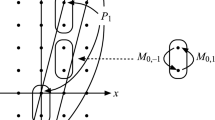Abstract
This sequel to our earlier paper (1995) continues the investigation of the Euler cubic curves therein defined, with particular reference to perspectivities and associated conics. Study of the circular cubic in this pencil, the Neuberg cubic, brings with it some discussion of the properties of circular cubics in general.
Similar content being viewed by others
Abbreviations
- Bennett:
-
See Isoptic
- Brocard:
-
Isogonal points P,Q in a triangle ABC for which all six angles PBC, PCA, PAB, QCB, QAC, QBA are equal
- De Longchamps:
-
Image of orthocentre H in circumcentre O
- Euler:
-
Point on circumcircle whose Simson line is parallel to OH
- Fermat:
-
Points F for which ⦔BFC = ⦔CFA = ⦔ AFB (two such)
- Hessian:
-
Points of intersection of the Apollonius circles; their pedal triangles are equilateral
- lsogonic:
-
See Fermat
- Isodynamic:
-
See Hessian
- Isoptic:
-
Point at which the 4 circumcircles of the component triangles of a quadrangle subtend equal angles
- Lemoine:
-
Isogonal conjugate (K) of centroid G
- Neuberg:
-
Point on circumcircle whose Simson line is perpendicular to OH
- Steiner:
-
Point on circumcircle whose Simson line is parallel to OK
- Symmedian:
-
See Lemoine; common point of symmedian lines
- Isogonal conjugates:
-
Points P, ¯P such that their joins to each vertex of a triangle form an angle having the same bisectors as the angle of the triangle there. They are polar conjugate points with respect to all conies through the tritangent centres
- Isotomic conjugates:
-
Points P, ¯P such that their joins to each vertex meet the opposite side at the ends of a segment with the same midpoint as the side. They are polar conjugates with respect to all conies through the centroid and the vertices of the anticomplementary triangle (see below)
- Brocard axis:
-
OK, mediator of join of Brocard points, containing Hessian points
- Cevians of P:
-
PA, PB, and PC
- Euler:
-
OH, containing also centroid G, 9-point centre and De Longchamps point
- Simson line:
-
Join of feet of perpendiculars from a point of the circumcircle to sides BC, CA, AB
- Symmedians:
-
Reflexions of medians in the angle bisectors
- Apollonius circles:
-
Three circles, one through each vertex for which the other two vertices are inverse
- Jerabek's hyperbola:
-
Rectangular, through ABCHO; isogonal conjugate of OH
- Kiepert's hyperbola:
-
Rectangular, through ABCHG; isogonal conjugate of OK
- Nine-point circle:
-
Through 3 diagonal points and 6 midpoints of the sides of quadrangle ABCH
- Steiner ellipse:
-
Touching sides at midpoints
- Tritangent circles:
-
Touching the three sides of a triangle, either externally or internally
- Darboux:
-
Auto-isogonal with pivot De Longchamps point
- Euler:
-
Member of pencil of auto-isogonal cubics with pivot on Euler line
- Feuerbach:
-
Euler cubic with pivot at Nine-point centre
- Lucas:
-
Locus of isotomic conjugate points whose join contains the isotomic conjugate of H
- McCay:
-
Euler cubic with pivot at circumcentre O
- Neuberg:
-
Locus of isogonal conjugates whose join is parallel to OH; Euler cubic with pivot at infinity on OH
- Ortho:
-
Euler cubic with pivot at orthocentre H
- Thomson:
-
Euler cubic with pivot at centroid G
- Cevian:
-
LMN, where AP meets BC at L, &c
- Anticevian:
-
Triangle L′M′N′ for which ABC is the Cevian triangle of P; [AL, PL′] = −l, &c
- Complementary:
-
A′B′C, where A′ is the midpoint of BC, &c. B′C is parallel to CB, &c
- Anticomplementary:
-
A″B″C″, where B″AC″ is a line parallel to CB, &c
- Pedal:
-
DEF, where PD is perpendicular to B C, &c
- Antipedal:
-
Triangle D′E′F with respect to which ABC is the pedal triangle of P. E′AF is perpendicular to AP, &c
- Cyclopedal:
-
XYZ, where AP meets circumcircle again at X,&c
References
COURT, N.A.:College Geometry, Barnes & Noble, 1952.
COXETER, H.S.M.: Some applications of trilinear coordinates,Linear Algebra 226–8, (1995), 375–388.
CUNDY, H.M.: Curves and conjugacy; a tour of some interesting geometry,Math. Gaz. 80 (1996), 216.
CUNDY, H.M. & PARRY, C.F.: Some cubic curves associated with a triangle,J. Geom. 53 (1995), 41–66.
DARBOUX, G.:Nouvelles Annales de Math. (2)5 (1866), 420–5.
EDDY, R.H. & FRITSCH, R.: The conics of Ludwig Kiepert,Math. Mag. 67 (1994), 188–205.
JOHNSON, R.A.:Advanced Euclidean Geometry, 1929, reprinted Dover 1960.
KIMBERLING, C.:Triangle Centres and Central Triangles, Utilitas Mathematica Publishing, Inc., Winnipeg 1998.
McCAY, H.S.: On three similar figures,Trans. Royal Irish Acad. 29 (1887–92), 303–320.
MORLEY, F. & MORLEY F.V.:Inversive Geometry, Bell, London 1933.
NEUBERG, J.: Memoire sur la tetraedre,Acad. Royale des Sciences 37 (1886), 64.
PARRY, C.F.: Steiner-Lehmus & the automedian triangle,Math. Gaz. 75 (1991), 151–154.
PINKERNELL, G.M.: Cubic curves in the triangle plane,J. Geom. 55 (1996), 141–161.
ROBSON, A.:An Introduction to Analytical Geometry, II, Cambridge University Press, Cambridge, 1947.
THOMSON, F. D.:Education Times 2 (1864), 57.
WOOD, P.W.: Points isogonally conjugate with respect to a triangle,Math. Gaz. 25 (1941), 266–272.
YFF, P.: Two families of cubics,MAA Notes 34 (1994), 127–137.
Author information
Authors and Affiliations
Rights and permissions
About this article
Cite this article
Cundy, H.M., Parry, C.F. Geometrical properties of some Euler and circular cubics. Part 1. J Geom 66, 72–103 (1999). https://doi.org/10.1007/BF01225673
Received:
Issue Date:
DOI: https://doi.org/10.1007/BF01225673



